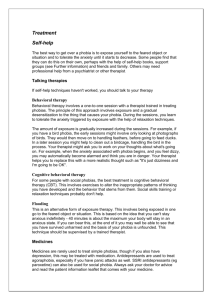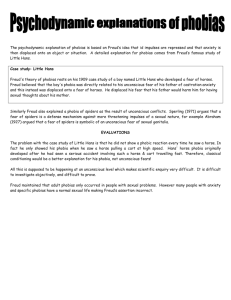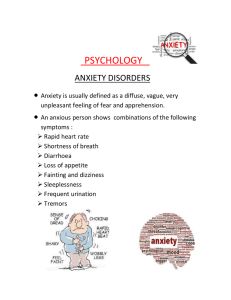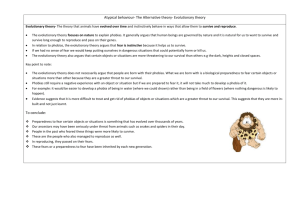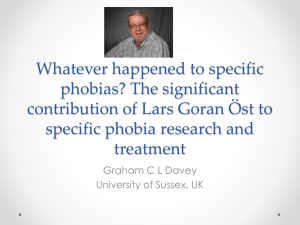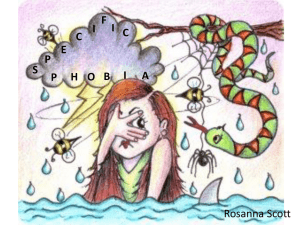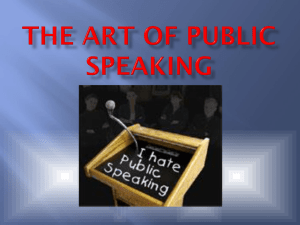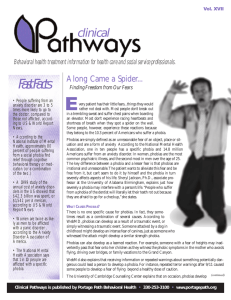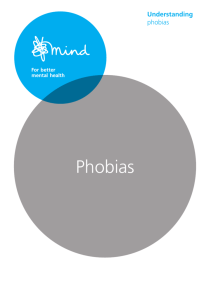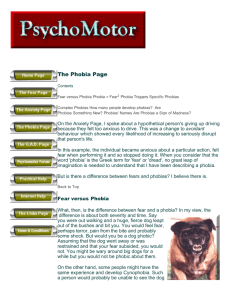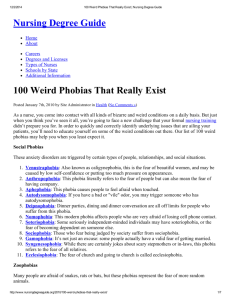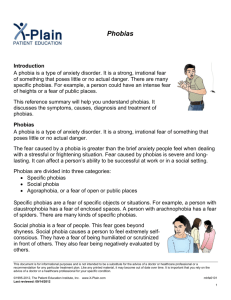A Guide to Phobias
advertisement
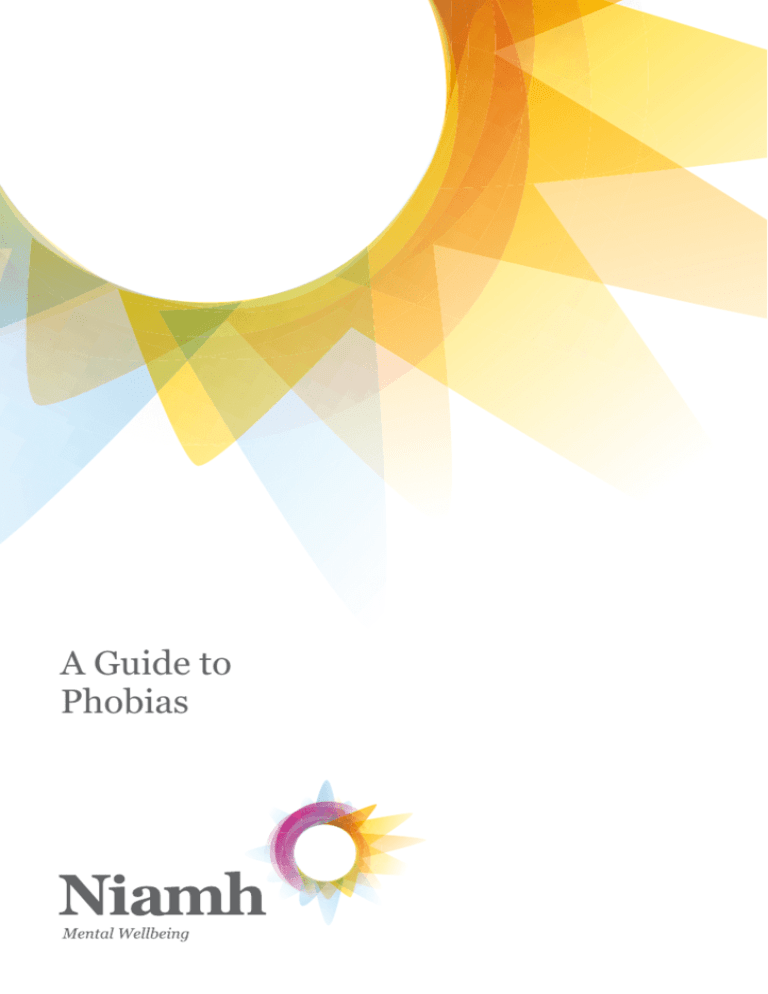
A Guide to Phobias A phobia is strong fear or dread of a thing or event which is out of proportion to the reality of the situation. The most effective treatment is cognitive behaviour therapy (CBT). Antidepressant medication also helps in many cases. Niamh | A Guide to Phobias What are the symptoms of phobia? There are different types of phobia If you come near to, or in contact with, the feared situation you become anxious or distressed. In addition you may also have one or more unpleasant physical symptoms. For example: a fast heart rate, palpitations, feeling sick, shaking (tremor), sweating, dry mouth, chest pain, a ‘knot in the stomach’, fast breathing. Social phobia Social phobia is possibly the most common phobia. With social phobia you become very anxious about what other people may think of you, or how they may judge you. Therefore, you fear meeting people, or ‘performing’ in front of other people, especially strangers. You fear that you will act in an embarrassing or humiliating way, and that other people will think that you are stupid, inadequate, weak, foolish, crazy, etc. You avoid such situations as much as possible. The physical symptoms are partly caused by the brain which sends lots of messages down nerves to various parts of the body when you are anxious. In addition, you release ‘stress’ hormones (such as adrenaline) into the bloodstream when you are anxious. These can also act on the heart, muscles and other parts of the body to cause symptoms. You may even become anxious by just thinking of the feared situation. You end up avoiding the feared situation as much as possible, which can restrict your life and cause suffering. Agoraphobia This too is common. Many people think that agoraphobia means a fear of public places and open spaces. But this is just part of it. If you have agoraphobia you tend to have a number of fears of various places and situations. For example, you may have a fear of: • entering shops, crowds, and public places. •travelling in trains, buses, or planes. •being on a bridge or in a lift. •being in a cinema, restaurant, etc, where there is no easy exit. niamhwellbeing.org But they all stem from one underlying fear. That is, a fear of being in a place where help will not be available, or where you feel it may be difficult to escape to a safe place (usually to your home). When you are in a feared place you become anxious and distressed, and have an intense desire to get out. Therefore, to avoid this anxiety many people with agoraphobia stay inside their home for most or all of the time. Other specific phobias There are many other phobias of a specific thing or situation. For example: claustrophobia (fear of confined spaces or of being trapped); fear of certain animals; fear of injections or needles; fear of vomiting; fear of being alone; fear of choking; fear of the dentist; fear of flying; But there are many others, some quite rare. What is the treatment for phobias? •Cognitive-behaviour therapy (CBT) CBT helps you to change certain ways that you think, feel and behave. It is a useful treatment for various mental health problems, including phobias. Cognitive therapy is based on the idea that certain ways of thinking can trigger, or ‘fuel’, certain mental health problems such as anxiety, depression and phobias. The therapist helps you to understand your current thought patterns. In particular, to identify any harmful, unhelpful, and ‘false’ ideas or attitudes which you have that can make you anxious. The aim is then to change your ways of thinking to avoid these ideas. Also, to help your thought patterns to be more realistic and helpful. •Behaviour therapy Behaviour therapy aims to change any behaviours which are harmful or not helpful. For example, with phobias your response to the feared object (anxiety and avoidance) is not helpful. Niamh | A Guide to Phobias The therapist helps you to change this. Various techniques are used, depending on the condition and circumstances. For example, for agoraphobia the therapist will usually help you to face up to feared situations, a little bit at a time. A first step may be to go for a very short walk from your home with the therapist who gives support and advice. Over time, a longer walk may be possible, and then a walk to the shops, then a trip on a bus, etc. The therapist may teach you how to control anxiety when you face up to the feared situations and places. For example, by using deep breathing exercises. This technique of behaviour therapy is called ‘exposure therapy’ where you are exposed more and more to feared situations, and learn how to cope. •Cognitive-behaviour therapy Cognitive-behaviour therapy (CBT) is a mixture of the two where you may benefit from changing both thoughts and behaviours. CBT is usually done in weekly sessions of about 50 minutes each, for several weeks. You have to take an active part, and are given ‘homework’ between sessions. For example, you may be asked to keep a diary of your thoughts which occur when you become anxious. Note: unlike other forms of talking treatments (psychotherapy), CBT does not ‘look into the events of the past’. CBT aims to deal with your current thought processes and/or behaviours, and helps to change them where appropriate. CBT usually works well to treat most phobias, but does not suit everyone. However, it is not available on the NHS in all areas. niamhwellbeing.org Antidepressant medicines These are commonly used to treat depression, but they also help to reduce the symptoms of phobias (particularly agoraphobia and social phobia), even if you are not depressed. They work by interfering with brain chemicals (neurotransmitters) such as serotonin which may be involved in causing anxiety symptoms. •Antidepressants do not work straight away. It takes 2-4 weeks before their effect builds up. A common problem is that some people stop the medicine after a week or so as they feel that it is doing no good. You need to give it time. •Antidepressants are not tranquillisers, and are not usually addictive. •There are several types of antidepressants, each with various ‘pros and cons’. For example, they differ in their possible side-effects. However, SSRI antidepressants (selective serotonin reuptake inhibitors) are the ones most commonly used for anxiety and phobic disorders. • Note: after first starting an antidepressant, in some people anxiety symptoms become worse for a few days before they start to improve. A combination of cognitive-behaviour therapy and an SSRI antidepressant may work better in some cases than either treatment alone. Benzodiazepines such as diazepam These medicines are sometimes called ‘minor tranquillisers’. They work well to ease symptoms of anxiety. The problem is, they are addictive and can lose their effect if you take them for more than a few weeks. They may also make you drowsy. Therefore, they are not a useful long-term treatment of phobias. However, a short course, or even a single dose, may be useful for a phobia which occurs rarely. For example, if you have a fear of flying in a plane, a short course just before a flight may help. Niamh | A Guide to Phobias Further help information and advice National Phobics Society Zion Community Resource Centre 339 Stretford Road, Hulme Manchester M15 4ZY Telephone 0870 122 2325 www.phobics-society.org.uk NO PANIC (National Organisation For Phobias, Anxiety, Neuroses, Information & Care) 93 Brands Farm Way, Randlay Telford, Shropshire TF3 2JQ Helpline 0808 808 0545 www.nopanic.org.uk Triumph Over Phobia (TOP UK) PO Box 3760, Bath BA2 3WY Telephone 0845 600 9601 www.triumphoverphobia.com Runs a national network of structured, self-help groups for adults (16+) suffering from phobias. Dental Anxiety & Phobia Association 104 Harley Street, London W1G 7JD Telephone 020 7935 8092 www.healthyteeth.com Gut Reaction www.gut-reaction.freeserve.co.uk Gut Reaction was formed in 1994 by a life-long sufferer of emetophobia, a fear of vomiting. Needlephobia.co.uk www.needlephobia.co.uk Needlephobia’s correct name is “Belonephobia”. It can be defined as a fear of sharp objects such as pins or needles. This website, run by Smith & Nephew, includes information for the general public and professionals affected by this issue with regard to healthcare. British Association for Behavioural and Cognitive Psychotherapies www.babcp.com Their website has lots of information on CBT, and a ‘Find a Therapist’ facility. niamhwellbeing.org ©EMIS 2010, as distributed on http://www.patient.co.uk/health/ Phobias.htm Used with permission. Northern Ireland Association for Mental Health 80 University Street Belfast BT7 1HE Telephone 028 9032 8474 Fax 028 9023 4940 info@niamhwellbeing.org niamhwellbeing.org Niamh is a company limited by guarantee Charity Reference Number XN47885 Company Number NI 25428
